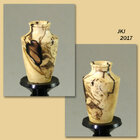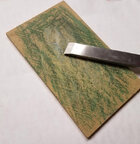You old guys will laugh at this since you already know what I’m about to write…
…CBN wheel from D-way, 220 grit I was still getting tear out and doing a lot of sanding, usually starting at 80 grit.
… 600 grit CBN wheel. I bought it. Delivery kept being delayed and it finally arrived a couple days ago. —and no tear out! Started sanding at 180.
No laughing here, not even a chuckle! (Caveat - I am an old guy and have some experience but I’m in no way an “expert.”)
I teach what I call “sharp, sharp, sharp, shaving sharp” and demonstrate by shaving hair off my arm.
I think tear out can be a combination of things like:
- tool used
- turning technique
- the type of wood
- figure and grain orientation
- localized problem spots in the wood
- and tool control
IMO sharp, sharp, sharp tools can make a huge difference.
(There are things, such as surface treatment, that can be done to minimize tear out, but sharp sharp turmps sharp)
After experimenting for years with various sharpening methods (conventional grinding wheels, Tormek water wheel, various CBN grits, different grinds), I am quite happy with my current setup:
- 60 grit CBN on bench grinder for shaping/reshaping tools (I use the “1/2 speed” bench grinders).
- 600 grit CBN on bench grinder for sharpening almost everything.
- 1200 grit CBN on a Tormek (no water) for sharpening my spindle gouges.
I use the 600 grit for skews, parting tools, bedan, bowl gouges, scrapers, negative rake scrapers, hand scrapers, etc.
I remove any burrs by stropping on the Tormek flat and contoured leather wheels.
All scrapers have a burnished burr applied by hand.
When needed, I restore the “shaving sharp” edges on skews with my custom honing board.
Note: I did try a 600 grit CBN on the Tormek but like the 1200 grit better for my spindle gouges, put the 600 on the shelf. (I keep multiple identical spindle gouges and when one starts to get dull I set it aside and get out another one and keep turning. When all are dull, I sharpen them all.)
Besides the sharpness, I think tool control is the biggest issue. Unfortunately, starting and sticking primarily with bowl turning is not always the quickest way to go. Some experts suggest starting with spindle turning to learn fine tool control. I strongly agree.
They say perfecting spindle turning first teaches that tool control that will let you turn anything - unfortunately, they say it doesn’t work the other way.
(I have references and my own observations of students.)
Unfortunately, spindle turning is not glamorous the to the turner addicted to bowls, bowls, and bigger bowls. (I have other addictions.)
But when I observe some of the best woodturners I know, ALL of them are extremely good with spindles - even though they can turn anything.
BTW, when I started turning I learned mostly from books, then took a class on bowl turning. There, I was taught what turned out to be several very bad techniques about turning and sanding, I’ve since learned better ways. I now turn bowls and platters with rarely a spot of tearout,, smooth with NRS and hand scrapers, and usually start sanding (by hand) with 320 grit, sometimes start at 400. I have one piece I show to students/at demos that was sanded only with 600 grit. (Don’t get me wrong, this is not for bragging rights - I’ll certainly go to coarser grits if needed.) Also, I now NEVER power sand with rotating disks. With other methods there is no need, and far less dust goes into the air. Most of my sanding is by hand with a small piece of sandpaper backed up with a soft eraser. And I’d be lost without my custom hand scrapers.
One big note: I almost always turn dry wood, small or large. (The biggest problem is GETTING dry wood without spending a fortune but that can be solved) Don’t misunderstand, I HAVE turned a lot of green over the years and it’s far easier to turn (almost too easy) but I don’t like the wet mess, the smoothing process and the natural warping. I know many do and that’s OK with me. There are enough green wood bowl turners, I’d rather do something else.
(There is a little trick John Lucas taught me to repair the occasional small speck of tear out, described earlier here at least once.)
Oh, and to really experience the difference, try chip carving (or any carving by hand) without razor sharp tools. Or better, don’t.
JKJ




